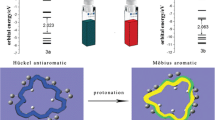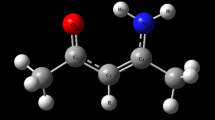Abstract
In this work, the molecular geometry of heptachlor is investigated using ab initio HF, DFT, LDA, and GGA methods. The natural bond orbital (NBO) analysis is performed at the B3LYP/6-311++G(d,p) level of theory. The first order hyperpolarizability βtotal, the mean polarizability Δα, the anisotropy of the polarizability Δα, and the dipole moment μ, are calculated by B3LYP/6-311++G(d,p) and HF/6- 311++G(d,p) methods. The first order hyperpolarizability (βtotal) is calculated based on the finite field approach. UV spectral parameters along with HOMO, LUMO energies for heptachlor are determined in vacuum and the solvent phase using HF, DFT, and TD-DFT/B3LYP methods implemented with the 6-311++G(d,p) basis set. Atomic charges and electron density of heptachlor in vacuum and ethanol are calculated using DFT/B3LYP and TD-DFT/B3LYP methods and the 6-311++G(d,p) basis set. In addition, after the frontier molecular orbitals (FMOs), the molecular electrostatic potential (MEP), the electrostatic potential (ESP), the electron density (ED), and the solvent accessible surface of heptachlor are visualized as a results of the B3LYP/6-311++G(d,p) calculation. Densities of states (DOS), the external electric field (EF) effect on the HOMO-LUMO gap, and the dipole moment are investigated by LDA and GGA methods.
Similar content being viewed by others
References
Toxicological Profile for Chlordane (Draft), US Public Health Service, US Department of Health and Human Services, Agency for Toxic Substances and Disease Registry (ATSDR), Atlanta, GA (1992).
Toxicological Profile for Heptachlor: Heptachlor Epoxide, US Public Health Service, US Department of Health and Human Services, Agency for Toxic Substances and Disease Registry (ATSDR), Atlanta, GA (1993).
Toxicological Profile for Toxaphene, US Public Health Service, US Department of Health and Human Services, Agency for Toxic Substances and Disease Registry (ATSDR), Atlanta, GA (1990).
J. Keilhorn, S. Schmidt, I. Mangelsdorf, and P. Howe, Heptachlor. Concise International Chemical Assessment Document 70, Fraunhofer ITEM, Hanover, Germany, Centre of Ecology and Hydrology, Monks Wood, UK, World Health Organization, Switzerland (2006).
E. R. Steffneyi, M. Y. Peter, F. C. Linda, et al., Toxicol. Lett., 104, 127–135 (1999).
M. Kerkhoff, J. de Boer, and J. Geerdes, Sci. Total Environ., 19, 41–50 (1981).
P. R. Becker, E. A. Mackey, R. Demiralp, et al., Chemosphere, 34, 2067–2098 (1997).
P. A. Stehr-Green, J. C. Wohlleb, W. Royce, et al., J. Am. Med. Assoc., 259, No. 3, 374–377 (1988).
M. D. Salman, J. S. Reif, L. Rupp, et al., J. Toxicol. Environ. Health, 31, No. 2, 125–132 (1990).
M. A. Mora, Arch. Environ. Contam. Toxicol., 31, 533–537 (1996).
Persistent Organic Pollutants Assessment Report, International Programme on Chemical Safety (IPSC), Inter Organization Programme for the Sound Management of Chemicals (IOMC) (1995).
M. D. Reuber, J. Toxicol. Environ. Health, 5, No. 4, 729–748 (1979).
M. D. Reuber, J. Environ. Pathol., Toxicol. Oncol., 7, No. 3, 85–114 (1987).
Integrated Risk Information System (IRIS) on Chlordane, US Environmental Protection Agency, Environmental Criteria and Assessment Office, Office of Health and Environmental Assessment, Office of Research and Development, Cincinnati, OH (1993).
S. Telang, C. Tong, and G. M. Williams, Carcinogenesis, 3, 1175–1178 (1982).
R. J. Ruch, R. Fransson, S. Flodstrom, et al., Carcinogenesis, 11, No. 7, 1097–1101 (1990).
K. S. Kang, M. R. Wilson, T. Hayashi, et al., Environ. Health Perspect., 104, No. 2, 192–200 (1996).
J. M. Soler, E. Artacho, J. D. Gale, et al., J. Phys.: Condens. Matter, 14, 2745–2779 (2002).
J. P. Perdew and A. Zunger, Phys. Rev. B, 23, 5048–5079 (1981).
Y. Zhang and W. Yang, Phys. Rev. Lett., 80, 890 (1998).
L. P. Perdew, K. Burke, and M. Ernzerhof, Phys. Rev. Lett., 77, 3865–3868 (1996).
N. Troullier, J. L. Martins, et al., Phys. Rev. B, 43, 1993–2006 (1991).
L. Kleinman and D. M. Bylander, Phys. Rev. Lett., 48, 1425–1428 (1982).
M. J. Frisch et al., Gaussian 09, Revision A.1, Gaussian Inc., Wallingford, CT (2009).
K. G. Shields and C. H. L. Kennard, J. Chem. Soc., Perkin Trans. 2, 1374–1376 (1973).
J. R. Durig, T. S. Little, T. K. Gounev, et al., J. Mol. Struct., 375, 83–94 (1996).
F. L. Huyskens, P. L. Huyskens, and A. P. Person, J. Chem. Phys., 108, 8161–8171 (1998).
J. Olsen and P. J. Jørgensen, J. Chem. Phys., 82, 3235–3264 (1985).
T. U. Helgaker, H. J. A. Jensen, and P. J. Jørgensen, J. Chem. Phys., 84, 6280–6284 (1986).
Y. G. Sıdır and İ. Sıdır, J. Mol. Struct., 1045, 131–138 (2013).
Y. G. Sidir, İ. Sıdır, E. Tasal, et al. Int. J. Quant. Chem., 111, 3616–3629 (2011).
E. Scrocco and J. Tomasi, Adv. Quantum Chem., 11, 115–193 (1978).
F. J. Luque, J. M. Lopez, and M. Orozco, Theor. Chem. Acc., 103, 343–345 (2000).
M. W. Wong, M. J. Frisch, and K. B. Wiberg, J. Am. Chem. Soc., 113, 4776–4782 (1991).
E. Cances, B. Mennucci, and J. Tomasi, J. Chem. Phys., 107, No. 8, 3032–3041 (1997).
Author information
Authors and Affiliations
Corresponding author
Additional information
Original Russian Text © 2015 Y. Gülseven Sıdır, İ. Sıdır, F. Demiray.
The text was submitted by the authors in English. Zhurnal Strukturnoi Khimii, Vol. 56, No. 7, pp. 1339-1353, November-December, 2015.
Rights and permissions
About this article
Cite this article
Gülseven Sıdır, Y., Sıdır, İ. & Demiray, F. Structural and electronic properties of heptachlor. J Struct Chem 56, 1275–1289 (2015). https://doi.org/10.1134/S0022476615070070
Received:
Revised:
Published:
Issue Date:
DOI: https://doi.org/10.1134/S0022476615070070




